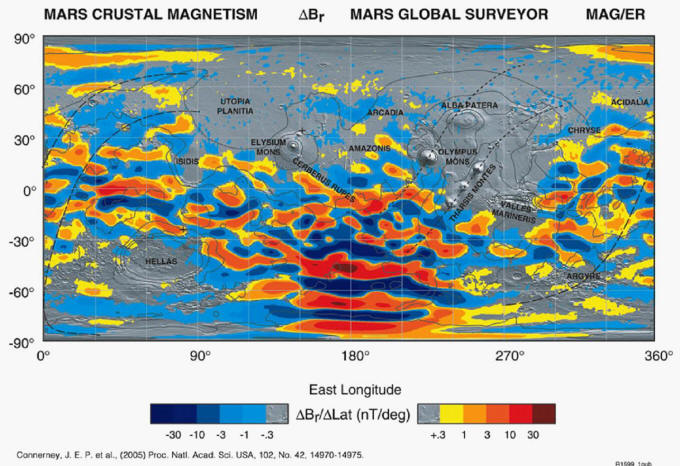|
|
Martian Auroras
Aug 19, 2009
Mars has no global magnetic
field, so the fortuitous discovery
of an aurora event near the south
pole surprised astronomers.
Terrestrial auroras are thought to
be generated when the Earth’s
magnetic field deflects solar wind
particles to the magnetic poles. The
particles are somehow accelerated
along magnetic field lines, and when
the lines dive toward the surface,
the particles collide with atoms in
the atmosphere, causing the atoms to
emit light.
Indications of thousands of aurora
events turned up in a review of
space probe data. Reviewers
constructed a map of occurrences and
found that they clustered around the
margins of magnetic patches on the
surface. The patches are thought to
be crustal rocks that have preserved
magnetic fields acquired from an
ancient global field that has
decayed. Why they occur almost
entirely in the southern hemisphere
is not understood.
Theorists speculate that the solar
magnetic field lines, which are
thought to be “frozen” into the
solar wind, “break” and reconnect to
the crustal field lines, “flinging”
electrons to high energies. It’s “a
physical process still not
understood.”
Astronomers might begin to
understand if they did some homework
in the pages of the plasma science
journals. Magnetic field lines are
symbolic representations of what in
reality is a continuous measure of
magnetic force. The lines are a
convention to indicate the direction
of the force at each point in space,
and their spacing indicates the
strength. But the lines, being
imaginary constructs, cannot
“freeze” or break or reconnect or
“fling” anything. Attributing
actions to imaginary constructs is a
lazy excuse for failing to describe
actual mechanisms that, in this
case, have already been described by
others.
Charged particles streaming in the
same direction as the magnetic field
constitute “field aligned currents,”
or Birkeland currents, named after
the Norwegian scientist who, in the
late 19th century, first proposed
their existence as the cause of
auroras. Birkeland currents generate
“double layers” along their paths as
the current fluctuates. Double
layers are regions of electrostatic
charge separation maintained by the
forces in the current. Strong
electric fields build up between the
layers, and charged particles that
flow into these regions are
accelerated to high energies.
It’s no wonder astronomers fail to
understand: they have reversed cause
(electric currents) and effect
(magnetic fields), they have denied
the existence or downplayed the
importance of the electrical
processes, and they have asked the
wrong questions. The magnetism in
the patches is reinforced by, if not
entirely generated by, the current
channels that enclose the patches.
Because a persistent current must be
part of a larger circuit,
astronomers should be asking why the
currents are especially strong in
the southern hemisphere, and where
do they go. Where’s the rest of the
circuit?
The Electric Universe suggests that
the answer likely has something to
do with the different planetary
configuration indicated by the
cosmogonic stories of prehistoric
peoples. Common themes and images
found in ancient cultures around the
globe point to electrical
interactions between Earth and Mars,
in which Earth’s northern polar
region and Mars’s southern polar
region were swept by an electrical
vortex similar to what may be seen
today, at much higher energies, in
the penumbras of sunspots.
It’s likely that crustal rocks from
Earth could be electrically
deposited on Mars and heated. If
they cooled below the Curie point
before the current and its
accompanying magnetic field
completely decayed, they would
retain the magnetism. Since Mars has
no global magnetic field in which
the spots would appear merely as
local deflections, they stand out as
foci for aurora events.
Mel Acheson
|
|
|
|
|
|
SPECIAL NOTE - **New Volumes Available:
We are pleased to announce a new
e-book series
THE UNIVERSE ELECTRIC. Available now, the first volume
of this series, titled Big Bang, summarizes the failure of modern cosmology
and offers a new electrical perspective on the cosmos. At
over 200 pages, and
designed for broadest public appeal, it combines spectacular
full-color graphics with lean and readily understandable
text.
**Then second and third volumes in the series are now available,
respectively titled Sun and Comet, they offer
the reader easy to understand explanations of how and why these bodies
exist within an Electric Universe.
High school and college students--and teachers in
numerous fields--will love these books. So will a large
audience of general readers.
Visitors to the Thunderbolts.info site have often
wondered whether they could fully appreciate the Electric
Universe without further formal education. The answer is
given by these exquisitely designed books. Readers from
virtually all backgrounds and education levels will find them
easy to comprehend, from start to finish.
For the Thunderbolts Project, this series is a milestone.
Please see for yourself by checking out the new
Thunderbolts Project website, our leading edge in
reaching new markets globally.
Please visit our
Forum
|
|
|
|
|
|
|
|







